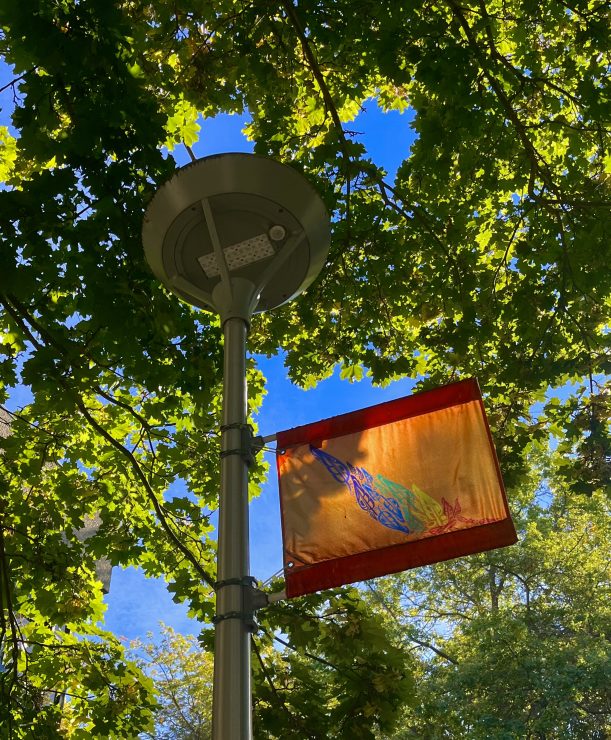A breakdown of UVic’s 2023 Indigenous Plan

Photo by Sage Blackwell.
The University of Victoria has released their 2023 Indigenous Plan (IP). Purposefully created in conjunction with the university’s new Strategic Plan, Distinctly UVic, the IP details UVic’s Indigenous-focused vision for the future.
The IP’s web page addresses UVic’s “commitment to implement responsibilities and calls to action from all levels of government in support of the rights and sovereignties of Indigenous Peoples.”
Additionally, whereas the previous IP responded to the Truth and Reconciliation Commission (TRC) Calls to Action, the new plan also includes consideration of the BC Declaration of the Rights of Indigenous People Act (BC DRIPA) Action Plan.
The Indigenous Plan Steering Circle (IPSC) guided the plan’s renewal, with the Office of the Vice-President Indigenous and other Indigenous members of the UVic community meeting at least monthly for more than a year.
According to Qwul’sih’yah’maht (Dr. Robina Thomas), vice-president Indigenous, the previous IP made progress on its goals, but crucial areas of focus, like LGBTQ2S+ relations, weren’t included, which is where the new Indigenous Plan refocused its attention.
The 2023 plan is based on the Coast Salish weaving framework which, in effect, means that the plan’s priorities (people, learning and teaching, research and re-searching, and governance and operations) are woven through the laws and philosophies of the plan (work together, bring in your good heart and mind, be prepared for the work to come, and remember our ancestors and birthright).
While this is not an exhaustive summary of the Indigenous Plan, the result is a comprehensive model that looks something like this.
Work together | Nəc̓əmaat kʷəns čeʔi | ĆȺNEUEL OL
This teaching calls on “all members of the university community [to] respectfully contribute to a culture of collaboration and cooperation.”
The governance and operations strand aims to support faculties and divisions in “identify[ing] and resourc[ing]” required staff positions by encouraging communication within the UVic community.
The people strand looks to revise compensation, ensure suitable workloads and alleviate unreasonable ones, and foster relationship-oriented and strengths-based Indigenous student relations.
The creation of funding opportunities for Indigenous community members to support and sustain research initiatives is prioritized in the research and re-searching section.
This learning and teaching priority area promises to partner with Knowledge Keepers and Elders to responsibly integrate Indigenous ways of knowing on campus and provide opportunities for learning and co-teaching in diverse settings.
Bring in your good heart and mind | Nəw̓es šxʷ cən ʔay̓ šqʷeləqʷən | ÁMEḴT TŦEN ÍY, ŚḰÁLEȻEN
The Indigenous Plan’s next teaching calls the community to ensure “the health, well-being, and equitable treatment of all people are prioritized in the policies, practices, systems, and structures of the university.”
Here, governance and operations focuses on the expansion of dispute resolution protocols.
People aims to recognize and celebrate the knowledge and value of Indigenous students within and outside of the classroom.
Research and re-searching prioritizes recognizing and supporting Indigenous research.
Learning and teaching seeks to ensure that students and teachers are recognized as knowledge holders and community and family members with responsibilities.
Be prepared for the work to come | Leʔt šxʷ helə ʔə cə mak̓ʷ sčeʔi səʔ | S,HOI EI MEQ EN ENA SE SĆȺ
Through the four priority areas, this teaching asks that “funding, resources, and capacity are sufficient to deliver sustainable and responsive educational experiences, student services, programs, and supports to all members of the university community.”
Governance and operations prioritizes the transparency of metrics and data as well as creating more Indigenous leadership opportunities on campus.
The people strand focuses on providing resources necessary for living to Indigenous community members, ensuring that Coast Salish language and knowledge is highly valued, and expanding mentorship opportunities for Indigenous folks.
Research and re-searching looks to provide research opportunities and funding for students and fund projects headed by the community.
In learning and teaching, the plan aims to consult Indigenous communities when considering areas of educational interest, sufficiently fund courses that address community needs, and prepare students to respond to Indigenous calls to action through their programs so that they are equipped to respond to anti-Indigenous racism.
Remember our ancestors birthright | Héʔəkw ʔə cə čəléŋən ɫtə | HÁEQ TE OL TŦE ĆELÁ EN TE
The aim of this teaching, in all priority areas, is for “all members of the university community [to] understand and demonstrate how to live, learn, and work in right relationships with local lands, waters, and laws.”
In governance and operations, this means addressing colonial relationships through the alignment of university policies and Indigenous laws.
Through people, the IP aims to ensure that all employees are knowledgeable about the laws and history of the place where they work and create collaborative programs that will confront discrimination.
Research and re-searching focuses on supporting Indigenous research centers like CIRCLE.
Finally, the learning and teaching strand looks to implement knowledges of Indigenous culture and colonial histories in learning outcomes, create learning opportunities for students not in Indigenous-specific courses, “create opportunities for Indigenous students to engage with their own experiences, knowledges, lands, and languages”, and support Indigenous language programming.
Dr. Skip Dick, a Songhees Elder, speaks to his hope for the Indigenous Plan in a Words of Welcome statement at the head of the IP document, writing: “Changes are happening in our time. When a pebble is thrown into water, we see its ripples grow into waves.”
Qwul’sih’yah’maht (Dr. Robina Thomas), vice-president Indigenous, echoes Dr. Dick’s sentiment“I feel like this is a momentous occasion for the University of Victoria.”








